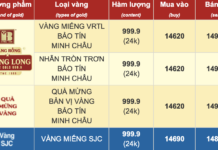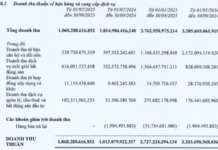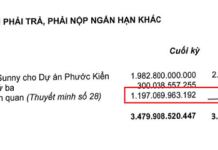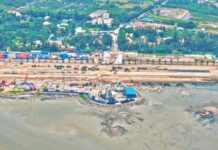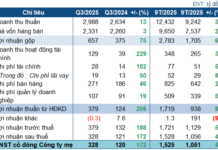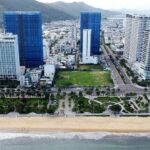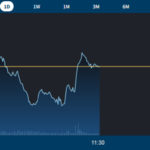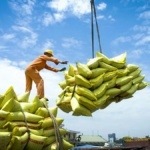The People’s Committee of Soc Trang province estimates that the preliminary total investment for Tran De Sea Port is approximately VND 162,730 billion, with an initial phase investment of VND 44,695 billion. In the first phase, public investment accounts for more than VND 19,400 billion (approximately 43% of the total), while investment from enterprises (socialization) amounts to nearly VND 25,300 billion (around 57%).
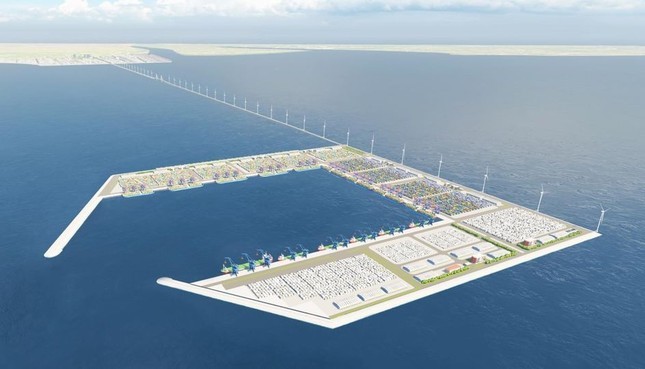
Tran De Port’s perspective.
In the initial phase, the state budget is used to invest in the construction of a road connecting the offshore Tran De wharf with the mainland, a sea-crossing bridge, a wave-breaking barrier, a ship channel, and a ship turning basin. Enterprise investment is utilized for land reclamation and the development of infrastructure for logistics services, as well as the construction of the port itself.
The total investment for the completion of Tran De Port is VND 162,731 billion. Of this, VND 46,476 billion is from public investment (approximately 29%), and the remaining VND 116,255 billion is from enterprise investment (around 71%). The allocation of funds remains similar to the first phase.
According to the People’s Committee of Soc Trang province, the Tran De Port project involves a significant investment with a slow capital recovery rate, and the investment location faces particular difficulties. As such, in addition to socializing investment in port infrastructure and warehouses, it is necessary to allocate state budget funds for investment in public maritime infrastructure, technical infrastructure, and transportation infrastructure.
This budgetary investment will enhance the attractiveness and effectiveness of the project, facilitating the attraction of private capital into the port area, similar to the successful investment calls for Lach Huyen and Lien Chieu ports in recent years.
The People’s Committee of Soc Trang province proposes that the Ministry of Transport and the Ministry of Planning and Investment submit to the Prime Minister for approval of central budget support for the project in the 2025-2030 period, with a total capital of VND 19,403 billion (for Phase 1 to develop basic infrastructure). Additionally, they request the inclusion of the project in the government’s program, aiming to complete the investment dossier for Tran De Port in 2025 and commence investment in 2026.
According to calculations by the Soc Trang provincial authorities, the investment scale of Tran De Port includes an offshore wharf (located approximately 18km from the shore) spanning more than 411 hectares (with an initial phase of over 81 hectares). The port will feature a 5.3km-long wharf that can accommodate general cargo ships, container ships with a capacity of up to 100,000 DWT (6,000-8,000 Teus), and bulk cargo ships of up to 160,000 DWT. In the initial phase, the focus is on developing two 800-meter-long berths for general cargo and container ships with a capacity of up to 100,000 DWT, along with two floating berths for bulk cargo (coal) transfer for vessels up to 160,000 DWT.
In 2023, the Mekong Delta region achieved a total import-export turnover of USD 35.7 billion, including exports of over USD 24 billion and imports of approximately USD 11 billion. The region contributes approximately 31% to the total GDP of the agricultural sector, accounting for around 50% of rice production, 95% of rice exports, 65% of seafood production, 60% of fish exports, and nearly 70% of fruit exports.
Currently, the region is home to 52 industrial parks and 28 export processing zones, with cargo transportation volume reaching about 35 million tons. The target for 2030 is to increase the cargo transportation volume to approximately 128 million tons.
According to the People’s Committee of Soc Trang province, despite the region’s significant import and export volume, the overall cargo transportation capacity remains low, relying mainly on inland waterways and road transport.
The Mekong Delta region needs a key port like Tran De to facilitate direct import and export of goods, reducing transportation costs and the volume of transshipment cargo to the Southeast region’s seaports. It is estimated that a large-scale seaport could decrease transportation costs by 30-50%, depending on the area, while also boosting socio-economic development, national defense, and security.
The New Land Price List Adjustment’s Impact on Ho Chi Minh City
The recent land price adjustments in Ho Chi Minh City are a significant move, reflecting the city’s development and the need to adapt to the changing reality. Despite short-term challenges, the new land price list brings about a host of positive impacts. It lays the foundation for a sustainable real estate market, promoting transparency, fairness, and the city’s comprehensive development while addressing the current situation.
Billion-Dollar Projects Seek Investors in Binh Dinh Province
The People’s Committee of Binh Dinh Province has recently unveiled plans to auction land-use rights for a prestigious development project. This project encompasses the construction of a 5-star hotel, office spaces for lease, and a vibrant commercial and service center in the heart of Nguyen Van Cu Ward, Quy Nhon City, Binh Dinh Province.










